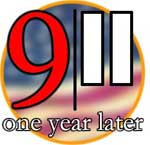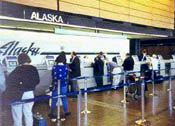Article
Airline kiosks and biometrics: a year later
In the wake of the 9/11 terrorist attacks, two kiosk-related segments retain a useful purpose for the airline and airport industries. But while the success of airline kiosks is obvious, it is harder to gauge the impact biometrics has had.
September 10, 2002
The events of Sept. 11, 2001, had a direct impact on many segments of American business. And the kiosk industry was no different.
In particular, two kiosk-related segments -- one an application, the other a technology -- gained greater awareness in the public eye following the events of 9/11.
For airline self-service check-in kiosks and biometrics technology, the past year has been one of awareness, growth, and consolidation. Both continue to play prominent roles in the daily routine of airports and airlines.
 |
Here's a review of what has happened:
Check-in kiosks
In the wake of the fear that overwhelemed airline passengers throughout the world following the terrorist attacks, the airline check-in kiosk application was reeling. Most major airlines, concerned over potential safety lapses, suspended their kiosk programs, and the president of the Association of Flight Attendants, Patricia Friend, called for their permanent ban.
Eventually, concerns over kiosks died down and most airlines had their programs back in service by mid-October.
By that time, the main benefit of check-in kiosks -- passenger convenience -- was becoming obvious to airlines, who were at the frontline of dealing with flyers aggravated by the long lines at new security checkpoints.
Jack Walsh, a spokesman for Alaska Airlines (NYSE:ALK), said that the kiosks provide a level of convenience by eliminating part of the waiting process -- the check-in line.
"The kiosks are so much more efficient for the routine check-in," Walsh said. "It reduces the length of lines. People aren't having to stand a lengthy amount of time to check in, and then do it again to go through security. And it helps our customer-service agents concentrate more on passengers who need individual service."
Walsh also said that checking in at a kiosk is reasonably secure because passengers still have to go through security.
Alaska Airlines is one of several airlines that maintained its enthusiasm for kiosks both before and after 9/11. The airline currently has about 370 kiosks deployed and has nearly reached full deployment.
"We have kiosks at close to every station," Walsh said. "There's a few where we don't have one due to the idiosyncrasies of the station. But at Barrow, Alaska, we have one. At Seattle, we have dozens."
Other airlines have expanded their programs. During the second quarter of 2002, Delta Air Lines (NYSE:DAL) increased the number of kiosks in its system from 131 to 380. America West Airlines (NYSE:AWA) purchased 40 kiosks in June, increasing the airline's deployment to 58. US Airways (NYSE:U) announced in April that it would expand its program from 166 to 251 kiosks.
 |
Alaska Airlines has about 370 self-service check-in kiosks in such varied locales as Seattle and Barrow, Alaska. |
Then there is Southwest Airlines (NYSE:LUV), which dropped its kiosk program in 2001 because a greater percentage of customers were booking their flights online and going ticketless. But in July, the airline announced that it would bring back kiosks in up to 13 airports, starting with Love Field in Dallas.
With a segment of its customer base committed to paper tickets, Southwest chose kiosks so it could transition those flyers to less expensive electronic tickets.
The company turned to IBM Corp. to supply the units as part of a 250-kiosk, $2 million contract.
"The kiosk has changed the airport experience for people willing to use them," Steve Orr, an executive in IBM's transportation industry group, told The Associated Pressat the time. "It can take people out of lines."
Consolidation gains traction
Biometrics, technology used to identify people through fingerprint and iris scans, among other means, shifted from an invasive to a sought-after technology following 9/11. Airports from coast to coast, including Boston's Logan International Airport and San Francisco International Airport, announced that they would trial biometrics-based identification machines.
A year later, the biometrics industry is indulging in the grow-merge-constrict routine that affects many developing markets.
Arguably the most notable move took place in late February, when Identix Inc. (NASDAQ:IDNX) and Visionics Corp. announced that the two companies would merge "in an effort intended to create the world's leading multi-biometric security technology." Following antitrust and SEC investigations and the approval of shareholders, the two companies merged on June 26.
The main concern at any company is the bottom line, and for publicly traded biometrics companies the story is mixed.
The bottom line looks healthy at Synaptics (NASDAQ:SYNA). During the third quarter of fiscal year 2002, ending March 31, the company reported net income of $2.4 million compared to $393,000 for the same period a year earlier. For the first nine months of the fiscal year, net income increased a staggering 3,151 percent, from $210,000 to $6.8 million.
Synaptics also sparkled in ways that are foreign to current market expectations. At a time when companies are reluctant to enter the stock market through an initial public offering, Synaptics on Feb. 1 completed the public sale of 5 million shares at $11 per share, raising $55 million. As of March 31, the company reported cash on hand and cash equivalents of $62.2 million, compared to $3.8 million on June 30, 2001.
"We believe our existing cash balances and the working capital line of credit with Silicon Valley Bank will be sufficient to meet our cash requirements at least through the next 12 months," the company stated in its third-quarter report with the Securities & Exchange Commission.
But Viisage Technology, whose products were part of a test at Logan International Airport in late 2001, reported a loss of $2.8 million for the second quarter ending June 30, compared to a $220,000 gain in the same period a year earlier.
While Viisage attracted more business and generated greater revenue in the quarter, $9 million compared to $6.9 million the previous year, the company's operating expenses and marketing costs rose significantly.
The biometrics industry appears to be segmenting itself, with individual companies seeking specialized market shares, making it hard to gauge how seriously some companies are approaching airline biometrics technology.
Viisage touted in its second-quarter report that it "has captured approximately 31 percent of the domestic driver's license market." On the other hand, Identix is focused on Internet and wireless security and has contracts with airports in such diverse locations as Logan International Airport and Charlottesville-Albemare Airport in Charlottesville, Va.
The overall response of the airport industry is hard to gauge because few are talking about their projects. While Identix sent out a press release in May announcing deals with a half-dozen airports, the airports themselves are keeping mum.






